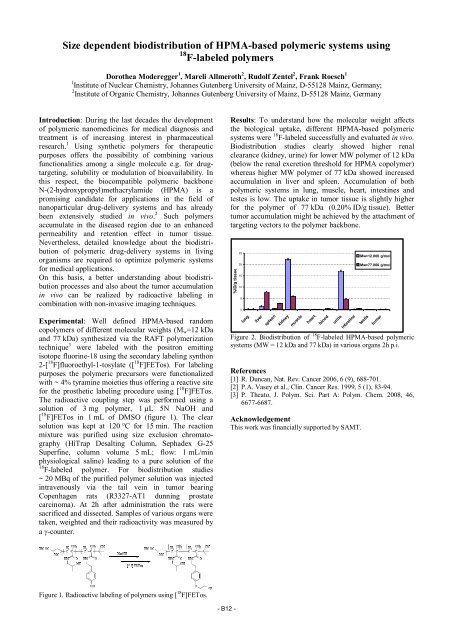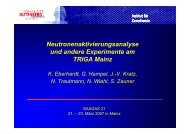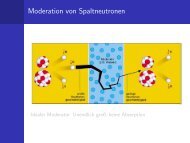institut für kernchemie universität mainz jahresbericht 2009
institut für kernchemie universität mainz jahresbericht 2009
institut für kernchemie universität mainz jahresbericht 2009
Create successful ePaper yourself
Turn your PDF publications into a flip-book with our unique Google optimized e-Paper software.
Size dependent biodistribution of HPMA-based polymeric systems using<br />
18 F-labeled polymers<br />
Dorothea Moderegger 1 , Mareli Allmeroth 2 , Rudolf Zentel 2 , Frank Roesch 1<br />
1 Institute of Nuclear Chemistry, Johannes Gutenberg University of Mainz, D-55128 Mainz, Germany;<br />
2 Institute of Organic Chemistry, Johannes Gutenberg University of Mainz, D-55128 Mainz, Germany<br />
Introduction: During the last decades the development<br />
of polymeric nanomedicines for medical diagnosis and<br />
treatment is of increasing interest in pharmaceutical<br />
research. 1 Using synthetic polymers for therapeutic<br />
purposes offers the possibility of combining various<br />
functionalities among a single molecule e.g. for drugtargeting,<br />
solubility or modulation of bioavailability. In<br />
this respect, the biocompatible polymeric backbone<br />
N-(2-hydroxypropyl)methacrylamide (HPMA) is a<br />
promising candidate for applications in the field of<br />
nanoparticular drug-delivery systems and has already<br />
been extensively studied in vivo. 2 Such polymers<br />
accumulate in the diseased region due to an enhanced<br />
permeability and retention effect in tumor tissue.<br />
Nevertheless, detailed knowledge about the biodistribution<br />
of polymeric drug-delivery systems in living<br />
organisms are required to optimize polymeric systems<br />
for medical applications.<br />
On this basis, a better understanding about biodistribution<br />
processes and also about the tumor accumulation<br />
in vivo can be realized by radioactive labeling in<br />
combination with non-invasive imaging techniques.<br />
Experimental: Well defined HPMA-based random<br />
copolymers of different molecular weights (Mw=12 kDa<br />
and 77 kDa) synthesized via the RAFT polymerization<br />
technique 3 were labeled with the positron emitting<br />
isotope fluorine-18 using the secondary labeling synthon<br />
2-[ 18 F]fluoroethyl-1-tosylate ([ 18 F]FETos). For labeling<br />
purposes the polymeric precursors were functionalized<br />
with ~ 4% tyramine moieties thus offering a reactive site<br />
for the prosthetic labeling procedure using [ 18 F]FETos.<br />
The radioactive coupling step was performed using a<br />
solution of 3 mg polymer, 1 µL 5N NaOH and<br />
[ 18 F]FETos in 1 mL of DMSO (figure 1). The clear<br />
solution was kept at 120 °C for 15 min. The reaction<br />
mixture was purified using size exclusion chromatography<br />
(HiTrap Desalting Column, Sephadex G-25<br />
Superfine, column volume 5 mL; flow: 1 mL/min<br />
physiological saline) leading to a pure solution of the<br />
18<br />
F-labeled polymer. For biodistribution studies<br />
~ 20 MBq of the purified polymer solution was injected<br />
intravenously via the tail vein in tumor bearing<br />
Copenhagen rats (R3327-AT1 dunning prostate<br />
carcinoma). At 2h after administration the rats were<br />
sacrificed and dissected. Samples of various organs were<br />
taken, weighted and their radioactivity was measured by<br />
a �-counter.<br />
Figure 1. Radioactive labeling of polymers using [ 18 F]FETos.<br />
Results: To understand how the molecular weight affects<br />
the biological uptake, different HPMA-based polymeric<br />
systems were 18 F-labeled successfully and evaluated in vivo.<br />
Biodistribution studies clearly showed higher renal<br />
clearance (kidney, urine) for lower MW polymer of 12 kDa<br />
(below the renal excretion threshold for HPMA copolymer)<br />
whereas higher MW polymer of 77 kDa showed increased<br />
accumulation in liver and spleen. Accumulation of both<br />
polymeric systems in lung, muscle, heart, intestines and<br />
testes is low. The uptake in tumor tissue is slightly higher<br />
for the polymer of 77 kDa (0.20% ID/g tissue). Better<br />
tumor accumulation might be achieved by the attachment of<br />
targeting vectors to the polymer backbone.<br />
%ID/g tissue<br />
- B12 -<br />
25<br />
20<br />
15<br />
10<br />
5<br />
0<br />
lung<br />
liver<br />
spleen<br />
kidney<br />
muscle<br />
heart<br />
blood<br />
urine<br />
intestine<br />
Mw=12.000 g/mol<br />
Mw=77.000 g/mol<br />
Figure 2. Biodistribution of 18 F-labeled HPMA-based polymeric<br />
systems (MW = 12 kDa and 77 kDa) in various organs 2h p.i.<br />
References<br />
[1] R. Duncan, Nat. Rev. Cancer 2006, 6 (9), 688-701.<br />
[2] P.A. Vasey et al., Clin. Cancer Res. 1999, 5 (1), 83-94.<br />
[3] P. Theato, J. Polym. Sci. Part A: Polym. Chem. 2008, 46,<br />
6677-6687.<br />
Acknowledgement<br />
This work was financially supported by SAMT.<br />
testis<br />
tumor

















